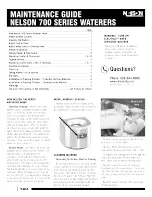
TM00358 Rev. A
Chapter 3 - Turret Environmental Protection
L-3 WESCAM
October 2007
All Rights Reserved
63
3.3
TURRET ENVIRONMENTAL PROTECTION
During flight, air flows around the external surface to passively decrease the inner temperature of the turret. During
ground operation, the inner temperature of the turret (in relation to the external air temperature) is much higher tha
n
in
f
ligh
t since there is no airflow.
The MX-15i system includes the features that follow for environmental protection:
•
a stow position that prevents damage to the windows
•
a desiccant assembly that keeps the turret internal air dry
3.3.1 Stow Position
The Stow position is an axial orientation of +150 degrees azimuth and +90 degrees elevation. It puts the windows of
the turret below the lid and between the turret yokes. This prev
ents damage to the windows fro
m unwante
d materia
l
or moisture.
3.3.2 Turret Desiccant Assembly
The desiccant assembly is designed to allow the turret to breath and exchange air. This movement of air is a
passive action designed to minimize pressure impacts from changes in altitude. Specifically, the desiccant assembly
functions to:
•
Inlet outside air into the turret and equalize pressure
•
Dry incoming air of any moisture or suspended salts
If moisture was permitted inside the turret, it would condensate on the sensor windows and degrade image quality.
Internal moisture would also be detrimental to internal electronics and corrode internal components.
The desiccant assembly is an integration of 5 elements:
•
Desiccant housing
•
Desiccant drying agent material
•
Desiccant humidity indicator
•
Breather valve
•
Air exchange nipple
The turret also incorporates a breather check-valve. When the desiccant assembly is installed, an air exchange
nipple opens to enable air exchange into the turret. When a desiccant assembly is removed, the turret’s breather
check-valve closes to seal the turret from any air exchange.
















































